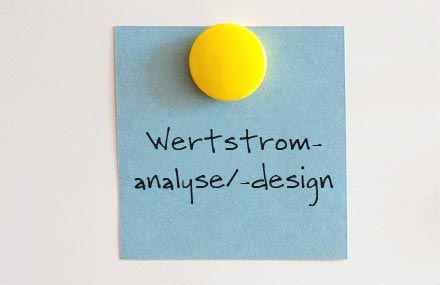
The ongoing competitive situation requires of all companies a constant optimisation of the establishment of performance. Today, more than ever, the focus of lean management, the design of production systems and a supply chain is on the holistic optimisation of value streams across company boundaries. Value Stream Mapping is a simple technique for visualising the actual state in order to identify and analyse waste and potential for improvement in corporate processes. Based on this, the improved target state is then developed in the value stream design.
What is Value Stream Mapping?
Value Stream Mapping is used to note and visualize the actual state of the process in detail. It is important to analyse the entire process and not just individual sub-steps of the process. For this purpose, all important figures, data and facts from the production processes as well as the material and information flow are included. The recording is visualised by simple symbols.
What goals are meant to be achieved with the application?
Value Stream Mapping is about the analysis of material and information flows with the goals:
- Representation of material and information flow and their interrelationships.
- Identification of weak spots and waste in the value stream
- Simplification of the information flow and improvement of transparency
- Basis for operational communication and discussion
- Basis for a value stream design with implementation measures and fields of action
Rules when performing the Value Stream Mapping Method
- Use paper and pencil
- Team building by involving all parties concerned
- Consider, understand and evaluate on-site
- Check the data basis and, if in doubt, collect new data
Approach
Recording and conception of holistic value-producing processes:
- Representation of material flows
- Representation of information flows (order entry control)
- Representation always from ramp to ramp (call-off/delivery behaviour)
Use of few, standardized symbols to represent the flows and process chains:
- - Everyone who works with value stream has the same understanding of the symbolism
- - This understanding is the basis for target-oriented discussions
Use of current process data:
- Process time, setup time, Overall Equipment Effectiveness (OEE), number of employees, batch size/container size, inventories, number of product variants, working hours/shift models
Transparency on waste:
- - Waiting times between processes, resulting inventories or bottlenecks.
Calculation of lead times and value added times
Detection of causes for waste and derivation of necessary implementation measures
What is value stream design?
Value Stream Design (builds on Value Stream Mapping and is used to redesign production towards an efficient and customer-oriented value stream. The result is a lean factory or a lean service operation. As with the value stream mapping, a diagram with corresponding symbols is used to visualise the desired improved state.
Which goals are to be achieved with the application?
Value Stream Design is about the design of material and information flows with the goals:
- Optimisation of production processes
- Reduction of inventories, lead times (DLZ), transport effort, space requirements
- Simplification of information flow and improvement of transparency
- Reduction of the operational control effort
- Increasing delivery reliability and customer orientation by increasing flexibility and reaction speed
- Basis for operational communication and discussion
- Basis for implementation measures and fields of action
Approach
Whereas value stream mapping was concerned with recording the current state, value stream design is used to
- derive the target state by identifying waste in the current state while finding and outlining new lean solutions,
- implement the outlined target state by first breaking it down into sub-steps, naming deadlines, milestones and persons responsible and implementing the sub-steps, and
- verify the implementation of the target state, correct it if necessary and standardise.
>
Copyright © 2022
Lean Management Consulting
